User:Riskchard/TextPage1

這列表列出28個由聯合國教科文組織制定,在英國和海外領土的世界遺產。[1] 當中十七個在英格兰,四個在蘇格蘭,三個在威爾士,一個位於北愛爾蘭,其餘海外領土包括百慕達,皮特肯群島及聖赫勒拿島各有一個。最先在1986年被列入世界遺產名冊的有巨人堤道、達勒姆座堂與達勒姆城堡和大教堂、鐵橋谷、斯塔德利皇家公園包括喷泉修道院遗址、 巨石陣、埃夫伯里和相關遺址、及圭内斯的爱德华国王城堡和城墙。最近被列入的是旁特塞斯特渡槽和运河在2009年。[2]
聯合國教育,科學及文化組織(通常簡稱教科文組織)在1946年11月4日正式成立。 它的目的是“保存和保護世界上書籍、藝術作品、歷史和科學古蹟的遺產”。[3]英國每年向世界遺產基金提供十三萬英鎊作為在发展中国家保存遺跡的資金。[4] Some designated properties contain multiple sites that share a common geographical location or cultural heritage.
The United Kingdom National Commission for UNESCO advises the British government, which is responsible for maintaining its World Heritage Sites, on policies regarding UNESCO.[5] In 2008, Andy Burnham – then Minister for Culture, Media, and Sport – voiced concerns over the worth of the designation of sites in the UK as World Heritage Sites and called for a review of the government's policy of putting forward new sites; this was partly due to rising costs and lower-than-expected income from visitors, few of which were aware of the World Heritage Site status of the sites they visited.[6]
World Heritage Site selection criteria i–iv are culturally related, and selection criteria vii–x are the natural criteria.[7] Twenty-three properties are designated as "cultural", four as "natural", and one as "mixed".[note 1][1] The breakdown of sites by type was similar to the overall proportions; of the 890 sites on the World Heritage List, 77.4% are cultural, 19.8% are natural, and 2.8% are mixed.[8] St Kilda is the only mixed World Heritage Site in the UK. Originally preserved for its natural habitats alone,[9] in 2005 the site was expanded to include the crofting community that once inhabited the archipelago; the site became one of only 25 mixed sites worldwide.[10] The natural sites are the Dorset and East Devon Coast; Giant's Causeway and Causeway Coast; Gough and Inaccessible Islands; and Henderson Island. The rest are cultural.[1]
位置
[编辑]二十八個由聯合國教科文組織制定的世界遺產中,十七個在英格兰,四個在蘇格蘭,三個在威爾士,一個位於北愛爾蘭,其餘海外領土包括百慕達,皮特肯群島及聖赫勒拿島各有一個。 以下地圖顯示目前所有世界遺產地點。

世界遺產
[编辑]The table lists information about each World Heritage Site:
- 名稱; 由世界遗产委员会列出[8]
- 地點; 在英國和海外領土,由聯合國教科文組織提供的
- 時期; time period of significance, typically of construction
- UNESCO data; Site reference number, the year the site was inscribed on the World Heritage List, and the criteria it was listed under
- Description; brief description of the site
| Name | Image | Location | Date | UNESCO data | Description |
|---|---|---|---|---|---|
| Blaenavon Industrial Landscape | 
|
Blaenavon, Wales 51°47′N 3°05′W / 51.78°N 3.08°W[11] |
19th century[11] | 984; 2000; iii, iv[11] |
In the 19th century, Wales was the world's foremost producer of iron and coal. Blaenavon is an example of the landscape created by the industrial processes associated with the production of these materials. The site includes quarries, public buildings, workers' housing, and a railway.[11] |
| Blenheim Palace | 
|
Woodstock, Oxfordshire, England 51°50′31″N 1°21′41″W / 51.841944°N 1.361389°W[12] |
1705–1722[12] | 425; 1987; ii, iv[12] |
Blenheim Palace, the residence of John Churchill, 1st Duke of Marlborough, was designed by architects John Vanbrugh and Nicholas Hawksmoor. The associated park was landscaped by Capability Brown. The palace celebrated victory over the French and is significant for establishing English Romantic Architecture as a separate entity from French Classical Architecture.[12] |
| Canterbury Cathedral, St Augustine's Abbey, and St Martin's Church | 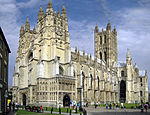
|
Canterbury, Kent, England 51°16′48″N 1°04′59″E / 51.28°N 1.083056°E[13] |
11th century[13] | 496; 1988; i, ii, vi[13] |
St Martin's Church is the oldest church in England. The church and St Augustine's Abbey were founded during the early stages of the introduction of Christianity to the Anglo-Saxons. The cathedral exhibits Romanesque and Gothic architecture, and is the seat of the Church of England.[13][14][15] |
| Castles and Town Walls of King Edward in Gwynedd | 
|
Conwy, Isle of Anglesey and Gwynedd, Wales 53°08′23″N 4°16′37″W / 53.139722°N 4.276944°W[16] |
13th–14th century[16] | 374; 1986; i, iii, iv[16] |
During the reign of Edward I of England (1272–1307), a series of castles were constructed in Wales with the purpose of subduing the population and establishing English colonies in Wales. The World Heritage Site covers many castles including Beaumaris, Caernarfon, Conwy, and Harlech. The castles of Edward I are considered the pinnacle of military architecture by military historians.[16][17] |
| City of Bath | 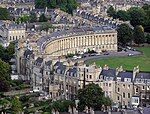
|
Bath, Somerset, England 51°22′51″N 2°21′37″W / 51.3809°N 2.3603°W[18] |
1st–19th century[18] | 428; 1987; i, ii, iv[18] |
Founded by the Romans as a spa, an important centre of the wool industry in the medieval period, and a spa town in the 18th century, Bath has a varied history. The city is preserved for its Roman remains and Palladian architecture.[18] |
| Cornwall and West Devon Mining Landscape | 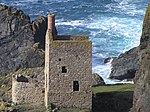
|
Cornwall and Devon, England 50°08′10″N 5°23′01″W / 50.136111°N 5.383611°W[19] |
18th and 19th centuries[19] | 1,215; 2006; ii, iii, iv[19] |
Tin and copper mining in Devon and Cornwall boomed in the 18th and 19th centuries, and at its peak the area produced two-thirds of the world's copper. The techniques and technology involved in deep mining developed in Devon and Cornwall were used around the world.[19] |
| Derwent Valley Mills | 
|
Derwent Valley, Derbyshire, England 53°01′13″N 1°29′59″W / 53.020278°N 1.499722°W[20] |
18th and 19th centuries[20] | 1,030; 2001; ii, iv[20] |
The Derwent Valley Mills was the birthplace of the factory system; the innovations in the valley, including the development of workers' housing – such as at Cromford – and machines such as the water frame, were important in the Industrial Revolution. The Derwent Valley Mills influenced North America and Europe.[21] |
| Dorset and East Devon Coast | 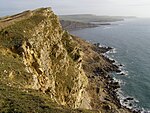
|
Dorset and Devon, England 50°42′20″N 2°59′24″W / 50.705556°N 2.989889°W[22] |
n/a | 1029; 2001; viii[22] |
The cliffs that make up the Dorset and Devon coast are an important site for fossils and provide a continuous record of life on land and in the sea in the area since 185 million years ago.[22] |
| Durham Castle and Cathedral | 
|
Durham, County Durham, England 54°46′30″N 1°34′32″W / 54.77487°N 1.57558°W[23] |
11th and 12th centuries[23] | 370; 1986; ii, iv, vi[23] |
Durham Cathedral is the "largest and finest" example of Norman architecture in England and vaulting of the cathedral was part of the advent of Gothic architecture. The cathedral houses relics of St Cuthbert and Bede. The Norman castle was the residence of the Durham prince-bishops.[23] |
| Frontiers of the Roman Empire | 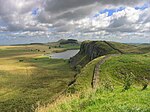
|
Northern England and southern Scotland 54°59′33″N 2°36′04″W / 54.992611°N 2.601°W[24] |
2nd century[24] | 430; 1987 (modified in 2005 and 2008); ii, iii, iv[24] |
Hadrian's Wall was built in 122 AD and the Antonine Wall was constructed in 142 AD to defend the Roman Empire from "barbarians".[24] The World Heritage Site was previously listed as Hadrian's Wall alone, but was later expanded to include all the frontiers of the Roman Empire at its zenith in the 2nd century, ranging from Antonine's Wall in the north to Trajan's Wall in eastern Europe.[8] |
| Giant's Causeway and Causeway Coast | 
|
County Antrim, Northern Ireland 55°14′27″N 6°30′42″W / 55.240833°N 6.511667°W[25] |
60–50 million years ago[25] | 369; 1986; vii, viii[25] |
The causeway is made up of 40,000 basalt columns projecting out of the sea. It was created by volcanic activity in the Tertiary period.[25] |
| Gough and Inaccessible Island | 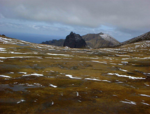
|
Saint Helena, Ascension and Tristan da Cunha, South Atlantic Ocean 40°19′05″S 9°56′07″W / 40.3181°S 9.9353°W[26] |
n/a | 740; 1995 (modified in 2004); vii, x[26] |
Together, the Gough and Inaccessible Islands preserve an ecosystem almost untouched by mankind, with many native species of plants and animals.[26] |
| Heart of Neolithic Orkney | 
|
Orkney, Scotland 58°59′46″N 3°11′19″W / 58.996056°N 3.188667°W[27] |
3rd millennium BC[27] | 514; 1999; i, ii, iii, iv[27] |
A collection of Neolithic sites with purposes ranging from occupation to ceremony. It includes the settlement of Skara Brae, the chambered tomb of Maes Howe and the stone circles of Stenness and Brodgar.[27] |
| Henderson Island | 
|
Henderson Island, Pitcairn Islands, Pacific Ocean 24°21′00″S 128°19′00″W / 24.35°S 128.316667°W[28] |
n/a | 487; 1988; vii, x[28] |
The island is an atoll in the south of the Pacific Ocean, the ecology of which has been almost untouched by man and its isolation illustrates the dynamics of evolution. There are ten plant and four animal species native to the island.[28] |
| Historic Town of St George and Related Fortifications, Bermuda | 
|
St George, Bermuda 51°22′51″N 2°21′37″W / 51.3809°N 2.3603°W[29] |
17th–20th centuries[29] | 983; 2000; iv[29] |
Founded in 1612, St George is the oldest English town in the New World and an example of planned urban settlements established in the New World in the 17th century by colonial powers. The fortifications illustrate defensive techniques developed through the 17th to 20th centuries.[29] |
| Ironbridge Gorge | 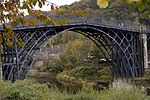
|
Ironbridge, Shropshire, England 52°37′35″N 2°29′10″W / 52.62646°N 2.486°W[30] |
18th century[30] | 371; 1986; i, ii, iv, vi[30] |
Ironbridge Gorge contains mines, factories, workers' housing, and the transport infrastructure that was created in the gorge during the Industrial Revolution. The development of coke production in the area helped start the Industrial Revolution. The Iron Bridge was the world's first bridge built from iron and was architecturally and technologically influential.[30] |
| Liverpool – Maritime Mercantile City | 
|
Liverpool, Merseyside, England 53°24′N 2°59′W / 53.40°N 2.99°W[31] |
18th and 19th centuries[31] | 1,150; 2004; ii, iii, iv[31] |
In the 18th and 19th centuries, Liverpool was one of the largest ports in the world. Its global connections helped sustain the British Empire, and it was a major port involved in the slave trade until its abolition in 1807, and a departure point for emigrants to North America. The docks were the site of innovations in construction and dock management.[31] |
| Maritime Greenwich | 
|
Greenwich, London, Greater London, England 51°28′45″N 0°00′00″E / 51.4791°N 0°E[32] |
17th and 18th centuries[32] | 795; 1997; i, ii, iv, vi[32] |
As well as the presence of the first example of Palladian architecture in England, and works by Christopher Wren and Inigo Jones, the area is significant for the Royal Observatory where the understanding of astronomy and navigation were developed.[32] |
| New Lanark | 
|
New Lanark, South Lanarkshire, Scotland 55°40′N 3°47′W / 55.66°N 3.78°W[33] |
19th century[33] | 429; 2001; ii, iv, vi[33] |
Prompted by Richard Arkwright's factory system developed in the Derwent Valley, the community of New Lanark was created to provide housing for workers at the mills. Philanthropist Robert Owen bought the site and turned it into a model community, providing public facilities, education, and supporting factory reform.[33] |
| Old and New Towns of Edinburgh | 
|
Edinburgh, Scotland 55°56′51″N 3°11′30″W / 55.947572°N 3.191631°W[34] |
11th–19th century[34] | 728; 1995; ii, iv[34] |
The Old Town of Edinburgh was founded in the Middle Ages, and the New Town was developed in 1767–1890. It contrasts the layout of settlements in the medieval and modern periods. The layout and architecture of the new town, designed by luminaries such as William Chambers and William Playfair, influenced European urban design in the 18th and 19th centuries.[34] |
| Pontcysyllte Aqueduct and Canal | 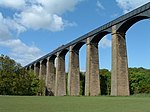
|
Trevor, Wrexham, Wales and Shropshire, England 52°58′14″N 3°05′16″W / 52.97053°N 3.08783°W[35] |
1795–1805[35] | 1,303; 2009; i, ii, iv[35] |
The aqueduct was built to carry the Ellesmere Canal over the Dee Valley. Completed during the Industrial Revolution and designed by Thomas Telford, the aqueduct made innovative use of cast and wrought iron, influencing civil engineering across the world.[35][36] |
| Royal Botanical Gardens, Kew | 
|
Kew, Greater London, England 51°28′29″N 0°17′44″W / 51.474667°N 0.295467°W[37] |
18th–20th century[37] | 1,084; 2003; ii, iii, iv[37] |
Created in 1759, the influential Kew Gardens were designed by Charles Bridgeman, William Kent, Capability Brown, and William Chambers. The gardens were used to study botany and ecology and furthered the understanding of the subjects.[37] |
| St Kilda | 
|
St Kilda, Scotland 57°49′00″N 8°35′00″W / 57.816667°N 8.583333°W[38] |
n/a | 387; 1987 (modified in 2005 and 2008); ii, iii, iv[38] |
Although inhabited for over 2,000 years, the isolated archipelago of St Kilda has had no permanent residents since 1930. The islands' human heritage includes various unique architectural features from the historic and prehistoric periods. St Kilda is also a breeding ground for many important seabird species including the world's largest colony of gannets and up to 136,000 pairs of puffins.[38][39] |
| Saltaire | 
|
Saltaire, City of Bradford, West Yorkshire, England 53°50′14″N 1°47′25″W / 53.83717°N 1.79026°W[40] |
1853[40] | 1,028; 2001; ii, iv[40] |
Saltaire was founded by mill-owner Titus Salt as a model village for his workers. The site, which includes the Salts Mill, featured public buildings for the inhabitants and was an example of 19th century paternalism.[40] |
| Stonehenge, Avebury and Associated Sites | 
|
Wiltshire, England 51°10′44″N 1°49′31″W / 51.178889°N 1.825278°W[41] |
4th–2nd millennia BC[41] | 373; 1986 (modified in 2008); i, ii, iii[41] |
The Neolithic sites of Avebury and Stonehenge are two of the largest and most famous megalithic monuments in the world. They relate to man's interaction with his environment. The purpose of the henges has been a source of speculation, with suggestions ranging from ceremonial to interpreting the cosmos. "Associated sites" includes Silbury Hill, Beckhampton Avenue, and West Kennet Avenue.[41] |
| Studley Royal Park including the Ruins of Fountains Abbey | 
|
North Yorkshire, England 54°06′58″N 1°34′23″W / 54.116111°N 1.573056°W[42] |
1132 (abbey), 19th century (park)[42] |
372; 1986; i, iv[42] |
Before the Dissolution of the Monasteries in the mid-16th century, Fountains Abbey was one of the largest and richest Cistercian abbeys in Britain and is one of only a few that survives from the 12th century. The later garden, which incorporates the abbey, survives to a large extent in its original design and influenced garden design in Europe.[42] |
| Tower of London | 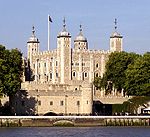
|
Tower Hamlets, Greater London, England 51°30′29″N 0°04′34″W / 51.508056°N 0.076111°W[43] |
11th century[43] | 488; 1988; ii, iv[43] |
Begun by William the Conqueror in 1066 during the Norman conquest of England, the Tower of London is a symbol of power and an example of Norman military architecture that spread across England. Additions by Henry III and Edward I in the 13th century made the castle one of the most influential buildings of its kind in England.[43] |
| Westminster Palace, Westminster Abbey and Saint Margaret's Church | 
|
Westminster, Greater London, England 51°29′59″N 0°07′43″W / 51.499722°N 0.128611°W[44] |
10th, 11th, and 19th centuries[44] | 426; 1987 (modified in 2008); i, ii, iv[44] |
The site has been involved in the administration of England since the 11th century, and later the United Kingdom. Since the coronation of William the Conqueror, all English and British monarchs have been crowned at Westminster Abbey. Westminster Palace, home to the British Parliament, is an example of Gothic Revival architecture; St Margaret's Church is the palace's parish church, and although it pre-dates the palace and was built in the 11th century, it has been rebuilt since.[44][45][46] |
Tentative list
[编辑]The Tentative List is an inventory of important heritage and natural sites that a country is considering for inscription on the World Heritage List, thereby becoming World Heritage Sites. The Tentative List can be updated at any time, but inclusion on the list is a prerequisite to being considered for inscription within a five- to ten-year period.[47]
The UK's Tentative List was last updated on 19 January 2006, and consisted of 15 sites. The properties on the Tentative List are as follows:[48]
- The Cairngorm Mountains, Scotland
- Chatham Naval Dockyard, England
- Darwin's Home and Workplace: Down House and Environs, England
- The Flow Country, Scotland
- The Forth Bridge, Scotland
- Fountain Cavern, Anguilla – a limestone cavern which contains Amerindian glyphs carved into the rock.[49]
- Gibraltar defences
- The Great Western Railway: Paddington-Bristol (selected parts), England
- Lake District, England
- Manchester and Salford (Ancoats, Castlefield and Worsley), England
- Monkwearmouth and Jarrow Monastic Sites, England
- Mount Stewart Gardens, Northern Ireland
- The New Forest, England
- Shakespeare's Stratford, England
- The Wash and North Norfolk Coast, England
Applicants for the tentative list
[编辑]Following the review of UK World Heritage Policy begun in December 2008, the government proposed to submit a new Tentative List to UNESCO in 2011, with a view to re-commencing nominations to the World Heritage List beginning in 2012 and beyond, although not necessarily every year.[50] Early in 2010 the government invited applications from local authorities and others, from throughout the UK, including the Overseas Territories and Crown Dependencies, for sites to be included on the new list. An independent expert panel was to be set up to advise Ministers on the applications, with a view to discouraging at an early stage, those applications which are unlikely to succeed.[50] On 7 July 2010 the Department for Culture, Media and Sport published a list of the 38 applicants received in the 2010 call for a new Tentative List, some of which were on the previous list. The 38 were:[50]
- Arbroath Abbey, Scotland
- The Birmingham Jewellery Quarter, England
- The Birth of the Railway Age, England – railway routes and stations in northern England, some of the earliest railways in the world[51]
- Blackpool, England
- The heroic period of civil and marine engineering in England 1822–1866, Bristol, England – four sites linked with Bristol's industrial heritage[52]
- Bronte Landscape and Haworth Village, England
- Brunel's Great Western Railway, England and Wales
- Buildings of Charles Rennie Mackintosh, Glasgow, Scotland
- Chatham Dockyard and its Defences, England
- Chester Rows, England
- Colchester, Camulodunum and Colonia Victricensis, England
- Creswell Crags, England
- The Hill of Derry, Northern Ireland
- The Dover Strait, England
- The Flow Country, Scotland
- The Forth Bridge, Scotland
- The Fountain Cavern, Anguilla
- Gorham's Cave, Gibraltar
- Gracehill Conservation area, Northern Ireland
- Jodrell Bank Observatory, England
- The Lake District, England
- The Laxey Valley, Isle of Man
- Historic Lincoln, England
- Malone and Stranmillis Historic Urban landscape, Belfast, Northern Ireland – an area of architectural interest featuring examples of the Arts and Crafts Movement[53]
- Merthyr Tydfil, Wales
- Merton Priory, England
- Mousa, Old Scatness and Jarlshof: The Crucible of Iron Age Shetland, Scotland
- The royal sites of Ireland – Navan Fort, Northern Ireland
- The Norfolk and Suffolk Broads, England
- Slate Industry of North Wales, Wales
- Offa's Dyke, England–Wales border
- St Andrews, Medieval Burgh and Links, Scotland
- Island of Saint Helena, Saint Helena Island, South Atlantic Ocean
- Turks and Caicos Islands, Caribbean
- Tynwald Hill and environs – Norse assembly sites of North West Europe, Isle of Man
- Former RAF Upper Heyford, England
- Wye Valley and Forest of Dean, England–Wales border
- City of York, England
See also
[编辑]- List of World Heritage Sites in Europe
- World Heritage Sites in Scotland
- Tourism in the United Kingdom
Notes
[编辑]- ^ A mixed site is one that falls under both natural and cultural criteria.
References
[编辑]- Notes
- ^ 1.0 1.1 1.2 United Kingdom of Great Britain and Northern Ireland: Properties inscribed on the World Heritage List, UNESCO, [2009-08-16]
- ^ Aqueduct crowned world 'wonder', BBC Online, 2009-06-27 [2009-08-17]
- ^ UNESCO Constitution, UNESCO, [2009-08-17]
- ^ Funding, Department for Culture, Media and Sport, [2009-08-17]
- ^ About us, The United Kingdom National Commission for UNESCO, [2009-08-17]
- ^ Andy Burnham launches debate on the future designation of World Heritage Sites in the UK, Department for Culture, Media and Sport, 2008-12-02 [2009-08-17]
- ^ The Criteria for Selection, UNESCO, [2009-07-27]
- ^ 8.0 8.1 8.2 World Heritage List, UNESCO, [2009-07-27]
- ^ New publication spotlights St Kilda, Scottish Natural Heritage, 2004-12-09 [2009-08-16]
- ^ Dual World Heritage Status For Unique Scottish Islands, National Trust for Scotland, 2005-07-14 [2009-08-16]
- ^ 12.0 12.1 12.2 12.3 Blenheim Palace, UNESCO, [2009-07-27]
- ^ 13.0 13.1 13.2 13.3 Canterbury Cathedral, St Augustine's Abbey, and St Martin's Church, UNESCO, [2009-08-15]
- ^ Church of St Martin, Images of England, [2009-08-16]
- ^ St Augustine's Abbey, Pastscape, [2009-08-16]
- ^ 16.0 16.1 16.2 16.3 Castles and Town Walls of King Edward in Gwynedd, UNESCO, [2009-08-12]
- ^ Liddiard (2005), p. 9.
- ^ 18.0 18.1 18.2 18.3 City of Bath, UNESCO, [2009-07-29]
- ^ 19.0 19.1 19.2 19.3 Cornwall and West Devon Mining Landscape, UNESCO, [2009-08-12]
- ^ 20.0 20.1 20.2 Derwent Valley Mills, UNESCO, [2009-07-27]
- ^ Derwent Valley Mills Partnership (2000), pp. 30–31, 96.
- ^ 22.0 22.1 22.2 Dorset and East Devon Coast, UNESCO, [2009-07-29]
- ^ 23.0 23.1 23.2 23.3 Durham Castle and Cathedral, UNESCO, [2009-07-27]
- ^ 24.0 24.1 24.2 24.3 Frontiers of the Roman Empire, UNESCO, [2009-07-28]
- ^ 25.0 25.1 25.2 25.3 Giant's Causeway and Causeway Coast, UNESCO, [2009-07-28]
- ^ 26.0 26.1 26.2 Gough and Inaccessible Island, UNESCO, [2009-08-12]
- ^ 27.0 27.1 27.2 27.3 Heart of Neolithic Orkney, UNESCO, [2009-07-28]
- ^ 28.0 28.1 28.2 Henderson Island, UNESCO, [2009-07-28]
- ^ 29.0 29.1 29.2 29.3 Historic Town of St George and Related Fortifications, Bermuda, UNESCO, [2009-08-02]
- ^ 30.0 30.1 30.2 30.3 Ironbridge Gorge, UNESCO, [2009-07-27]
- ^ 31.0 31.1 31.2 31.3 Liverpool – Maritime Mercantile City, UNESCO, [2009-07-29]
- ^ 32.0 32.1 32.2 32.3 Maritime Greenwich, UNESCO, [2009-07-29]
- ^ 33.0 33.1 33.2 33.3 New Lanark, UNESCO, [2009-07-28]
- ^ 34.0 34.1 34.2 34.3 Old and New Towns of Edinburgh, UNESCO, [2009-08-12]
- ^ 35.0 35.1 35.2 35.3 Pontcysyllte Aqueduct and Canal, UNESCO, [2009-08-12]
- ^ Listed Buildings: Pontcysyllte Aqueduct, Trevor, Wrexham County Borough Council, [2009-08-12]
- ^ 37.0 37.1 37.2 37.3 Royal Botanical Gardens, Kew, UNESCO, [2009-07-28]
- ^ 38.0 38.1 38.2 St Kilda, UNESCO, [2009-08-12]
- ^ Benvie (2000).
- ^ 40.0 40.1 40.2 40.3 Saltaire, UNESCO, [2009-07-28]
- ^ 41.0 41.1 41.2 41.3 Stonehenge, Avebury and Associated Sites, UNESCO, [2009-07-27]
- ^ 42.0 42.1 42.2 42.3 Studley Royal Park including the Ruins of Fountains Abbey, UNESCO, [2009-07-29]
- ^ 43.0 43.1 43.2 43.3 Tower of London, UNESCO, [2009-07-28]
- ^ 44.0 44.1 44.2 44.3 Westminster Palace, Westminster Abbey and Saint Margaret's Church, UNESCO, [2009-08-15]
- ^ History, Westminster Abbey, [2009-08-15]
- ^ Thornbury (1878), p. 567.
- ^ Glossary, UNESCO, [2010-01-01]
- ^ Tentative list of United Kingdom of Great Britain and Northern Ireland, UNESCO, 2006-01-19 [2010-01-01]
- ^ Foundation Cavern, Anguilla, UNESCO, [2010-01-01]
- ^ 50.0 50.1 50.2 From Chatham to Chester and Lincoln to the Lake District – 38 UK places put themselves forward for World Heritage status, United Kingdom Department for Culture, Media and Sport, 2010-07-07 [2010-07-07]
- ^ UK Tentative List of Potential Sites for World Heritage Nomination: Application form – The Birth of the Railway Age (PDF), United Kingdom Department for Culture, Media and Sport, [2010-12-02]
- ^ UK Tentative List of Potential Sites for World Heritage Nomination: Application form – The heroic period of civil and marine engineering in England 1822–1866 (PDF), United Kingdom Department for Culture, Media and Sport, [2010-12-02]
- ^ UK Tentative List of Potential Sites for World Heritage Nomination: Application form – Malone and Stranmillis Historic Urban landscape, Northern Ireland (PDF), United Kingdom Department for Culture, Media and Sport, [2010-12-02]
- Bibliography
- Benvie, Neil, Scotland's Wildlife, London: Aurum Press, 2000, ISBN 978-1-85410-978-1
- Derwent Valley Mills Partnership, Nomination of the Derwent Valley Mills for inscription on the World Heritage List, Derwent Valley Mills Partnership, 2000
- Keay, J; Keay, J, Collins Encyclopaedia of Scotland, London: Harper Collins, 1994, ISBN 0-00-255082-2
- Liddiard, Robert, Castles in Context: Power, Symbolism and Landscape, 1066 to 1500, Macclesfield: Windgather Press Ltd, 2005, ISBN 0-9545575-2-2
- Thornbury, Walter, St Margaret's Westminster, Old and New London (Victoria County History), 1878, 3
